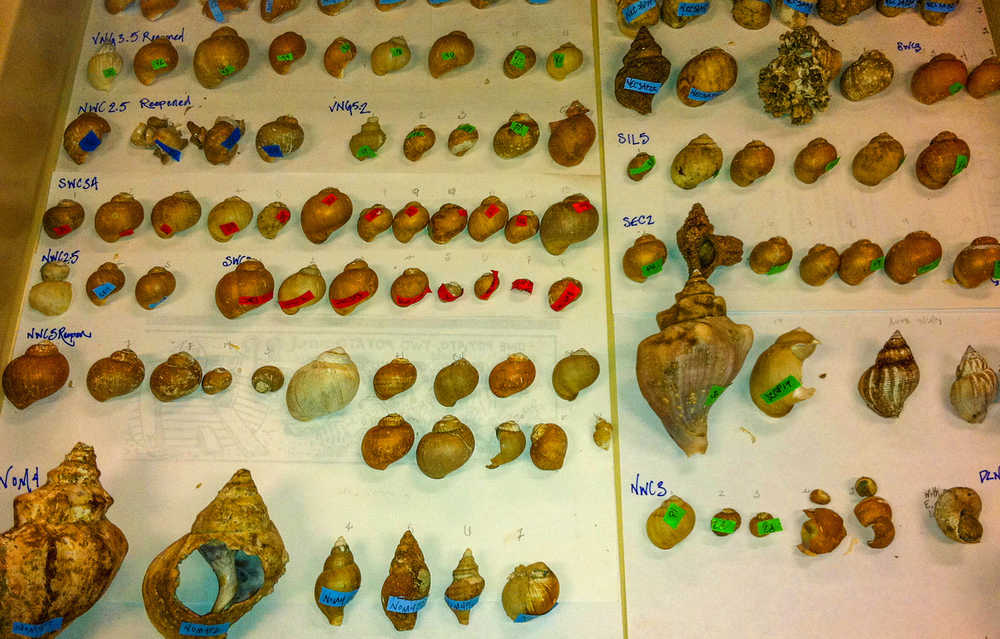After beachcombing at low tide, perchance coinciding with a full or new moon to maximize your success, be it at Captain Cook State Park or Homer’s Bishop’s Beach, you’re likely to end up with a small collection of shells, crab exoskeletons, or other remnants of marine life. Even without regard to the actual animals whose exoskeleton remains are now simply just seashells that adorn the mantle in your living room, the shells themselves have other ecological values.
The breakdown of shells provides nutrients for organisms that live in the ocean’s benthos (or bottom). This nutrient recycling is integral to the availability of calcium carbonate, the major compound in shells, coral, the exoskeleton of lobsters and crabs, and (importantly to Sockeye lovers) pteropods. Pteropods are the major food source of krill, which in turn is the major food source for juvenile salmon. Sea shells also provide habitats for multiple fish species at different stages in their life cycle, notably to hide from predation. Shells are used by shorebirds to build nests, by barnacles as a substrate to grow on, and by hermit crabs for protection.
The lowly hermit crab you might purchase from PetCo is often assumed to be a textbook example of one species that can’t exist without another in close proximity. That is to say, as a responsible hermit crab owner, your aquarium should hold gastropod (slugs, snails, whelks and periwinkles) shells of various sizes that your growing pet crustacean can use as disposable houses.
So you might think that hermit crab populations are dependent on gastropod populations. It turns out that’s not the case. As a graduate student at Southern Illinois University, I studied exactly that question by examining populations of hermit crabs and gastropods sampled at 52 sites around St. Lawrence Island with a trawl net by the U.S. Coast Guard’s icebreaker Healy. Although I tortured the data collected from the 10,000-square-mile study area with lots of different analyses, I couldn’t find any evidence to support the commonly held idea that hermit crab populations are geographically limited by gastropods. Further research is needed to explain how gastropod shells were available to hermit crabs without the living gastropods being present, even after accounting for migration by populations elsewhere — a mystery that remains unanswered.
Closer to home, there is another mysterious issue that plucks hard on the heart strings of those who remember Clam Gulch, just a few years ago, playing host to a heavy flow of Alaskans setting up shop with clam cannons and buckets full of razor clams. During the past two years, however, the abundance of razor clams has been shockingly low. The rapid population decline resulted in suspending all clamming activity from the mouth of the Kenai River to Homer in hopes that we set up future generations with a successful clam fishery.
The question of “where are the clams?” reaches beyond our Kenai Peninsula beaches. The same question is being asked in every state along the Pacific and Atlantic oceans. Clam fisheries are abruptly declining, causing those whose livelihood depends on a responsibly maintained clam fishery to desperately search for an answer and a solution. The Boston Clamdigger’s Association filed a lawsuit against Swissport, a company that provides Boston Logan International Airport with fuel. The lawsuit claims that the loss of harvestable clams in Boston Harbor was influenced by a huge fuel spill in 2010. Clams and other bivalves (mussels, oysters and scallops) filter water for movement and to acquire food, making bivalves sensitive to toxins even as they serve as a vector for humans to ingest toxins.
Unfortunately the same issue is true for the once lucrative fisheries of Long Island and Hudson Bay. After Hurricane Sandy, 76 clammers filed a lawsuit against the City of New York claiming wastewater from a treatment facility that lost power contaminated their fishery. Prior to Sandy, many blamed overharvesting of clams caused the demise of that fishery, which resulted in Manhattan chowder frequently (and ironically) served with clams imported from Florida. Like many other fisheries, the impact of harvesting such a large portion wasn’t considered until the population was in peril. However, is that the whole story —overfishing and pollution? There’s evidence that another factor is in play as well, and it starts at the beginning of the bivalve’s life cycle.
Poor larval growth and survival was first observed in wild oysters in 2005 with decreased fertilization rates and increased juvenile mortality due to the unavailability of calcium carbonate. Clams, crabs, lobsters and coral struggle from day one to grow because of a lack of the fundamental building block of their shells. Calcium carbonate is decreasing in marine systems, and it’s due to a chemical reaction taking place in every ocean of the world. When atmospheric carbon dioxide levels rise, their concentrations in the ocean increase as well, causing a chemical reaction makes the available carbonate less able to bind with calcium. This creates a more acidic environment with calcium carbonate levels sometimes low enough to inhibit larvae from maturing into shelled clams.
The finding of a simple seashell on a beach can be a reminder that gastropods and bivalves are both important but vulnerable to environmental change. While water treatment experimentation is underway to help clam and oyster hatcheries rebound, I try to leave the beach with a little less trash than when I arrived in hopes that my small efforts may help the plight of these shellfish.
Jen Peura is a seasonal biotech at the Kenai National Wildlife Refuge. Find more information at http://www.fws.gov/refuge/kenai/ or http://www.facebook.com/kenainationalwildliferefuge.

